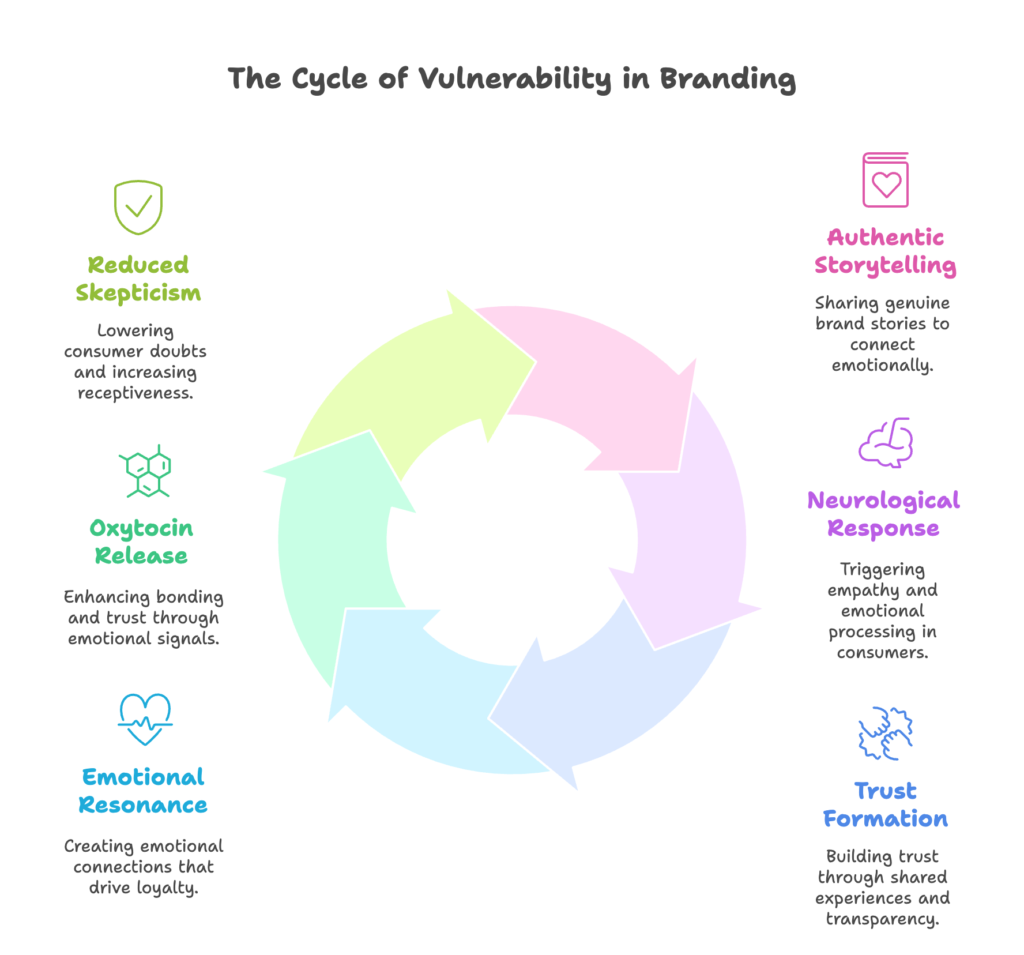Have you ever wondered why certain brands instantly feel relatable, while others seem distant and cold? There’s a simple yet powerful approach behind that warmth: shared vulnerability. By revealing honest experiences and challenges, you can spark trust with your shoppers in a way traditional marketing rarely manages. In this article, you’ll learn how to harness vulnerability for authentic marketing, bring it to life on Shopify, and nurture long-lasting connections that boost sales and loyalty. Sound intriguing? Let’s jump right in.
Understanding Shared Vulnerability in Brand Storytelling
In this section, you’ll discover what shared vulnerability means for e-commerce, how it’s different from conventional strategies, and why it matters for Shopify brand storytelling. You’ll also find out how to walk the fine line between genuine connection and giving away too much information. Ready to see what this approach offers? Let’s begin.

Defining Shared Vulnerability in the E-commerce Context
Shared vulnerability is about disclosing honest moments or lessons learned so that your audience feels a genuine sense of connection. Rather than pretending you’re flawless, you let shoppers see the real people behind the brand. In the e-commerce world, this could mean sharing a story about a product that initially failed but taught you something valuable. This openness is what turns a faceless business into a friendly ally, setting the stage for customer engagement that goes beyond a simple transaction.
The Psychology Behind Vulnerability in Consumer Connections
When shoppers notice honesty, their guard often goes down. By demonstrating humanity, brands can activate empathy in their audience’s minds. This feeling triggers a sense of acceptance and safety, factors that are especially vital for trust-building strategies. While traditional ads might highlight only the best angles, vulnerability says, “Here’s who we are—warts and all.” That can be far more memorable because it resonates with real human emotion.
How Vulnerability Differs from Traditional Marketing Approaches
Traditional marketing usually emphasizes a polished image. Vulnerability-based storytelling, however, brings out authenticity. Think of it this way: old-school promotions often focus on how amazing your product is. Vulnerability-based storytelling highlights the struggles, breakthroughs, and small victories that make your brand stand out in a real way. This distinction is especially helpful when aiming for DTC brand trust, because genuine stories are easier to believe and remember.
The Business Case for Authentic Vulnerability on Shopify
Being transparent can feel risky, but it pays off. Showing your brand’s human side encourages ecommerce brand loyalty because buyers remember brands that are relatable. Genuine stories can translate into higher conversion rate optimization by helping you stand out in crowded markets. Especially on Shopify, where competition is stiff, a brand that feels human can boost repeat purchases and referrals far more than generic messaging.
Distinguishing Between Vulnerability and Oversharing
It’s one thing to be open; it’s another to make people uneasy with overly personal details. The key is to share stories that connect back to your brand’s purpose or the shopper’s interests. Stay clear of deeply private topics that won’t help your audience or reflect your store’s identity. This balance of realness and relevance helps you project brand authenticity without crossing lines.
We’ve covered why vulnerability matters and how it sets you apart from traditional marketing. But how does this approach actually spark trust and loyalty in the human brain? Let’s explore that next.
The Science of Connection Through Vulnerability
In this section, you’ll see how neuroscience supports the power of authentic storytelling. We’ll look at how trust forms, how emotional resonance influences buying decisions, and the role of hormones like oxytocin in digital interactions. By the end, you’ll understand how vulnerability can reduce skepticism and build deeper connections. Let’s reveal the science.

Neurological Responses to Authentic Brand Stories
When consumers see sincerity in a brand’s message, it lights up the brain regions linked to empathy and emotional processing. These responses enhance memory retention, making it more likely that people will recall your brand later on. In other words, authenticity triggers the brain’s social bonding systems, which is a game-changer for Shopify brand storytelling.
Trust Formation Through Shared Experiences
Trust is often formed when people feel they’re not alone in facing certain struggles. By openly addressing your brand’s journey—whether it’s a product hiccup or a funny shipping mishap—shoppers see parallels with their own stories. This sense of shared experience reduces doubt and strengthens the connection that’s essential for customer engagement.
Emotional Resonance and Purchase Decision-Making
Emotions guide most of our purchasing choices. When a brand touches on universal feelings—like conquering a problem or celebrating growth—it activates emotional resonance. This not only encourages people to buy, but also fosters deeper brand loyalty. It’s a direct path to community-driven ecommerce, where shoppers feel like they’re part of something meaningful.
The Oxytocin Effect in Digital Brand Relationships
Oxytocin is sometimes called the “love hormone” because it’s tied to bonding and trust in social settings. A vulnerable story can spark a small surge of this hormone, even in a digital space. That emotional signal can amplify your brand’s likability and keep customers coming back, leading to stronger trust-building strategies over time.
How Vulnerability Counteracts Consumer Skepticism
People can be wary of ads, especially online. Vulnerability sends a message that you’re not trying to fool anyone. By sharing genuine experiences, you reduce the feeling that you have something to hide. This directness often makes shoppers more receptive, easing the skepticism that can undermine a purchase decision.
We’ve unpacked the science behind why vulnerability works. Next, we’ll look at how to put this strategy into practice on Shopify and make it a core part of your brand’s identity. Let’s keep going.
Strategic Implementation of Vulnerability in Shopify Stores
Now it’s time to bring ideas into action. This section shows you how to identify the right moments to be open, craft a narrative, maintain professionalism, and even weave vulnerability into your store’s design. By the end, you’ll have practical tips for turning authenticity into a key brand strength. Ready for the details? Let’s go.
Identifying Appropriate Vulnerability Touchpoints
Look for natural places where a personal story can enhance your brand. Maybe it’s the founding story: the spark that started your business. Or it could be a learning experience about product quality. The best touchpoints are those that spotlight real challenges or lessons that your audience can connect with.
Crafting Your Brand’s Vulnerability Narrative
Begin by mapping out your brand’s timeline: key obstacles faced, breakthroughs, and core values learned along the way. Then decide which parts of that timeline will strike a chord with your target market. Shape each piece into a short but honest story. Doing this ensures your brand’s vulnerability looks purposeful, rather than random.
Balancing Professionalism with Authentic Disclosure
Some topics may be raw, so use taste and tact. It’s helpful to remember that vulnerability is about sincerity, not drama. You can acknowledge mistakes or uncertainties without losing credibility. The goal is to create a bond and position your brand as relatable, not as a source of discomfort.
Vulnerability in Visual Design and User Experience
Photography, color choices, and page layouts can also add warmth. Consider showing behind-the-scenes images of your production process or using less corporate headshots of your team. These design elements can reinforce the narratives you share, offering a complete experience that feels genuine and inviting.
Technical Implementation on Shopify Platform
Shopify makes it simple to post personal stories through blog entries, landing pages, and customizable themes. Use sections that spotlight your brand’s journey on your homepage or About page. Experiment with apps that enable storytelling pop-ups or highlight user-generated content. These technical tools support a consistent message of vulnerability across your store.
You’ve seen how to apply vulnerability within your Shopify store framework. Next, we’ll see how to place this approach throughout the entire customer journey. Let’s continue.
Vulnerability Across the Customer Journey
This part examines where and when to share your open, honest side—from before a buyer even considers your product, right through long-term loyalty. By weaving authenticity into each stage, you set up a brand presence that feels steady and welcoming. Let’s discover how that works.
Pre-Purchase: Building Connection Through Origin Stories
At the awareness stage, origin stories can draw interest. Shoppers learn the “why” behind your brand, giving them a reason to pay attention. Talk about a tough start, a personal realization, or a unique gap you saw in the market. This first impression is crucial for consumer connections because it highlights a brand that’s honest from the get-go.
During Consideration: Transparent Product Development Narratives
When someone is weighing options, show them the ups and downs of product creation. Maybe share how a prototype failed but led to an improved design. Such transparency makes your product more convincing than any glossy ad could. It’s also a great way to illustrate your commitment to quality without sounding stiff.
Point of Purchase: Trust-Building Through Honest Policies
Right before checkout, shoppers often have final doubts. Ease them with clear return policies, shipping info, and product guarantees. Use direct language that says, “We stand by our goods, but we’re also human, so reach out if there’s a problem.” That sense of straightforwardness does wonders for conversion rate optimization and reduces abandoned carts.
Post-Purchase: Deepening Relationships Through Follow-up
After the sale, consider sending a personalized note or a short reflection on your brand’s journey. This extra touch can keep the connection alive. You could also invite new buyers to be part of a private group where they can discuss their experiences and share feedback, fostering more trust.
Long-term Loyalty: Creating Community Through Shared Values
Over the long haul, encourage regular conversation around shared values. This is where your brand can emphasize its commitment to openness, community, or sustainability. When shoppers see you consistently practicing what you say, they’re more likely to become loyal advocates who stick with you for the long run.
We’ve placed authenticity at every stage of the customer journey. Next, let’s look at Shopify-specific tools you can use to make all this happen more smoothly.
Shopify-Specific Tools for Vulnerable Storytelling
This section dives into the practical side of building an authentic presence: the About page, blog strategies, product descriptions, email marketing, and specialized apps. By the end, you’ll have a toolkit for weaving openness into every corner of your Shopify store. Let’s see what’s available.
About Page Optimization for Authentic Narratives
Your About page is often the first place shoppers go to discover your brand story. Use it to highlight the real reasons you started, the hiccups you faced, and the moments that shaped your mission. This is one of the simplest ways to reinforce brand authenticity and build a bond with potential buyers.
Blog and Content Marketing Strategies
Shopify has a built-in blogging feature that lets you share posts about product improvements, customer stories, and behind-the-scenes updates. These regular posts can keep your audience in the loop and make them feel more connected, all while boosting your brand’s presence in a natural, conversational style.
Product Description Frameworks That Incorporate Vulnerability
Instead of writing standard product details, consider weaving in a quick line about what inspired you to create the product or a lesson learned during testing. This approach can be especially powerful for consumer connections since it shows there’s a real person behind every listing.
Email Marketing Sequences That Build Connection
Automation on Shopify can be set up to send welcome emails, abandoned cart reminders, and post-purchase messages. Craft these emails to include a personal note or anecdote so they don’t feel purely transactional. A bit of humanity in your emails can motivate recipients to open future messages more often.
Leveraging Shopify Apps for Storytelling Enhancement
A range of Shopify apps for brand storytelling can help you feature user-generated content, manage testimonials, or integrate video stories right on your product pages. These tools streamline the process of sharing real-life moments and let shoppers see your authenticity in action.
You have the digital tools and platforms at your fingertips. Next, let’s see how other Shopify businesses have flourished by being transparent, and find inspiration for your own store.
Case Studies of Successful Vulnerability in E-commerce
Curious how vulnerability really works in practice? This section offers real examples, including small businesses on Shopify and major players like Patagonia. By examining how these brands turned openness into sales and loyalty, you’ll pick up tips to apply to your own store. Let’s discover these stories.
Small Business Success Stories on Shopify
Many small businesses have used vulnerability to thrive in niches. For instance, a jewelry store might openly discuss how they started with handmade prototypes in a tiny apartment, showing customers the passion and craft behind each piece. This kind of honest detail can set them apart in a crowded field.
How DTC Brands Use Vulnerability to Compete with Established Players
Direct-to-consumer brands often have limited budgets compared to huge corporations. A heartfelt story can level the playing field. By connecting with shoppers who admire transparency and approachability, these brands can secure loyal followers even if they lack the mainstream visibility of larger rivals.
Patagonia’s Transparent Approach to Sustainability
Patagonia is known for discussing its environmental impact with brutal honesty. Instead of glossing over areas where they need improvement, the company admits where they can do better. This open stance earns respect and loyalty, proving that radical honesty can be a strong way to stand out in any market.
Quantifying the Impact of Vulnerability on Conversion Rates
Brands that share genuine backstories often see more cart completions and higher average order values. While numbers vary by industry, the key takeaway is that emotional resonance encourages more frequent purchases. In an age of short attention spans, genuine bonds can be the difference between quick bounces and lasting relationships.
Lessons from Brands That Balance Vulnerability and Authority
Some brands risk going too far and losing credibility. The most successful examples demonstrate that you can be open about your struggles while still showcasing expertise. Shoppers want to see you as real, but also capable. Finding that balance is an ongoing process, and it’s worth the effort to get it right.
By learning from these examples, we see how authenticity can boost sales and brand loyalty. Now, let’s shift the spotlight to your customers and how they can become part of your narrative.
Customer-Centered Vulnerability Approaches
Here, we’ll explore techniques for bringing your shoppers into the story. By inviting them to share their own experiences, you amplify trust and create a mutual sense of belonging. Ready to see how customer participation can transform your store? Let’s dig in.
Featuring Customer Stories and Testimonials
Encourage customers to reveal how your products or services helped them overcome a problem or celebrate a milestone. Featuring these stories in your marketing materials is a great way to make your audience feel seen. It also shows prospective buyers that real people endorse your brand.
Co-Creating Narratives with Your Community
Invite shoppers to contribute ideas for new products or content. When users see their input reflected in final products, they develop a personal stake in your brand’s success. This community-driven approach can lead to a strong emotional bond that goes well beyond casual interest.
Responding to Feedback with Openness and Humility
Sometimes, things go wrong. A package arrives broken or a size runs small. Responding quickly and kindly can turn a setback into a story of responsible support. When buyers see you acknowledge shortcomings, they’re more likely to forgive them and remain loyal.
Building Platforms for Customer Expression
Setting up community forums, social media groups, or comment sections encourages open discussion. Shoppers feel more connected when they can share their wins or talk about improvements they’d like to see. This is a natural way to keep the cycle of trust alive and growing.
Measuring the Impact of Customer-Centered Vulnerability
A practical way to assess success is to compare engagement metrics (like comments, shares, or user-generated content submissions) before and after introducing customer stories. You can also look at repeat purchases and referral rates to see if you’re truly building that sense of belonging.
Next up, we’ll look at what to avoid, and how to handle potential pitfalls. Vulnerability is a powerful tool, but it must be managed carefully. Let’s keep moving.
Navigating Challenges and Pitfalls
Vulnerability can be a double-edged sword if not done with care. Here, you’ll learn how to stay authentic, respect privacy, address negative comments, and handle different cultural norms around openness. Let’s prepare for the rough patches so you can keep your brand on solid ground.
Avoiding Performative or Inauthentic Vulnerability
Shoppers can sense when a brand’s “openness” is just a marketing tactic. If stories feel staged, you might end up losing trust. Stick to real experiences and let those guide your messaging. True sincerity can’t be forced, so keep it genuine.
Managing Privacy Concerns and Boundaries
When telling personal stories, be mindful of how much detail you reveal about yourself, employees, or customers. Always respect privacy and seek permission before sharing someone else’s story. This shows integrity and prevents any unforeseen conflicts.
Responding to Criticism and Negative Feedback
Some might interpret vulnerability as weakness, or they might use it to point out flaws. Approach criticism calmly and politely. Acknowledge what you can improve and explain any misunderstandings without becoming defensive. This can reinforce the feeling that you are open and caring.
Cultural Considerations in Vulnerability Expression
Attitudes about openness differ across cultures. What feels normal in one location might be awkward or unwelcome in another. Research your audience’s backgrounds and adapt your communication to fit their comfort levels. This step prevents unintentionally crossing cultural boundaries.
When Vulnerability May Not Be Appropriate
Some topics are too personal, off-brand, or irrelevant. If the story doesn’t help your audience or connect to your brand’s purpose, it may be best to keep it private. Authenticity is powerful, but not every confession belongs in your store’s public space.
Now that you’re aware of the potential pitfalls, you can build a better strategy. Next, let’s discuss measuring results and proving that vulnerability has real value.
Measuring the Impact of Vulnerability in Storytelling
In this section, we’ll look at practical ways to gauge whether your openness is actually boosting sales, loyalty, and brand awareness. We’ll cover numeric benchmarks as well as more qualitative signals. Let’s see how to track progress.
Key Performance Indicators for Vulnerability-Based Marketing
Metrics like repeat purchase rate, average order value, and customer lifetime value can show whether your vulnerable approach is driving long-term loyalty. Keep an eye on email open rates or social media engagement, since these can also increase when you strike an emotional chord.
A/B Testing Frameworks for Vulnerable Content
Try comparing two versions of the same campaign: one featuring a personal story and one with standard marketing copy. Observe which version resonates more by tracking click-throughs, conversions, and time spent on page. This data-driven method can highlight the effect of authenticity on conversion rate optimization.
Qualitative Assessment Methods for Emotional Connection
Numbers only tell part of the story. Look at comments, direct messages, and conversations in online groups to see whether shoppers mention feeling personally connected to your brand. Screenshots of uplifting messages or heartfelt thanks can speak volumes about the power of vulnerability.
Long-term Brand Health Metrics
Keep tabs on brand sentiment over months or years. If your brand is consistently open and fair, you might see a rise in positive reviews and earned media mentions. Over time, your brand could develop a reputation for integrity that leads to organic growth without heavy advertising.
ROI Calculation Models for Vulnerability Investments
Assess the costs of creating vulnerable content—such as production hours for interviews or user-generated campaigns—against the revenue boosts from higher conversions and repeat business. If the figures show positive returns, you have clear evidence that genuine storytelling isn’t just feel-good fluff.
We’ve discussed how to measure progress. Now, let’s look at what the future holds for brand storytelling. There are exciting developments on the horizon, and vulnerability will likely remain a key part of them.
Future Trends in Authentic Brand Storytelling
This final section talks about how consumer expectations are changing and the technologies that will shape tomorrow’s conversations. You’ll also see how to mix AI personalization with human openness and maintain a consistent brand voice across channels. Let’s wrap things up by peeking into what’s coming next.
The Evolution of Consumer Expectations for Authenticity
Shoppers are becoming more aware of marketing tricks, and they often favor brands that are real and self-aware. This shift suggests that vulnerability will only grow in importance. People want to support businesses that reflect their own values and speak in a relatable way.
Emerging Technologies for Immersive Storytelling
Virtual and augmented reality, along with interactive videos, could make stories feel more real than ever. Imagine allowing users to see the behind-the-scenes of your workshop through a virtual tour. Such experiences could deepen bonds by bringing shoppers even closer to your brand’s daily life.
Balancing AI-Driven Personalization with Human Vulnerability
Personalization engines can tailor product recommendations, but they can’t replicate honest human stories. The ideal setup might be combining AI for data insights with genuine narratives for emotional resonance. This two-pronged method offers targeted suggestions and heartfelt engagement.
Cross-Channel Vulnerability Strategies
Consistency is key. Whether it’s on social media, via email, or inside your store’s blog, your brand’s voice should feel like one cohesive personality. This consistency ensures shoppers aren’t confused by conflicting messages or styles when they jump between channels.
Building a Sustainable Culture of Authentic Communication
Vulnerability can’t be a one-off. It’s most successful when it’s part of your brand’s everyday philosophy. Encourage your team to share honest updates and improvements regularly. Over time, this outlook becomes a signature trait, and your shoppers will sense it in all their interactions with you.
You’ve reached the end of our exploration of shared vulnerability in brand storytelling. Below, you’ll find resources that inspired this article, followed by a short reminder on how Growth Suite can help you boost your Shopify store’s revenue.
References
- A List Apart. (2023). “The Untapped Power of Vulnerability & Transparency in Content Strategy.” https://alistapart.com/article/the-untapped-power-of-vulnerability-transparency-in-content-strategy
- Davis, J. (2024). “How to Navigate Vulnerable Storytelling.” Jo Davis Art. https://jodavis.art/news/how-to-navigate-vulnerable-storytelling
- Lucas, J. (2023). “Unleashing the Power of Vulnerability in Advertising & Marketing.” LinkedIn. https://www.linkedin.com/pulse/unleashing-power-vulnerability-advertising-marketing-how-julio-lucas
- Ramey, S. (2024). “The Power of Vulnerability and Storytelling: Enhancing Your Communication with the Ramey Method.” The Scott Ramey. https://thescottramey.com/the-power-of-vulnerability-and-storytelling-enhancing-your-communication-with-the-ramey-method/
- Salzman, H. (2024). “Why vulnerability is the new strength in brand storytelling.” Creative Brief. https://www.creativebrief.com/bite/trend/guest-trend/why-vulnerability-is-the-new-strength-in-brand-storytelling
Ready to boost your Shopify store’s sales with optimized discount codes? Growth Suite is a Shopify app that can help you do just that. Install it with a single click and start seeing results!




